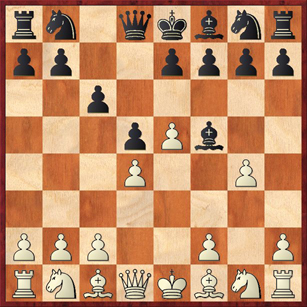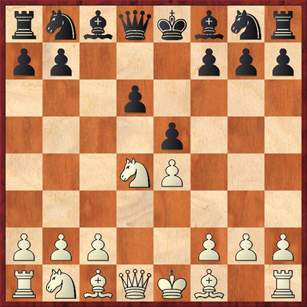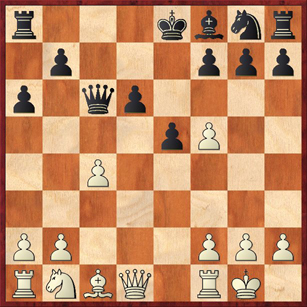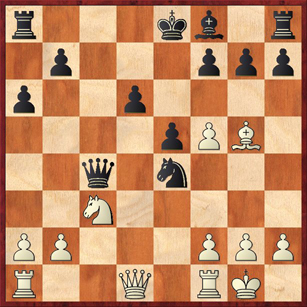Last night I met up with Gjon Feinstein, Santa Cruz’s resident chess teacher and a good friend of mine, for some chess conversation. He also invited two of the strong young players in Santa Cruz, Thadeus Frei and Cailen Melville, whom I have mentioned several times before in this blog. They were playing in a one-day tournament in San Jose, but they told Gjon they might be able to meet us on their way back from the tournament. Sure enough, they did!
It’s exciting for me to see two teenagers who are interested enough in chess to travel out of town to rated tournaments. Certainly that is partly due to Gjon’s encouragement. Thadeus tied for first yesterday with 3½ points out of 4. He was very modest about it and said oh well, there weren’t any players rated over 2000. But remember, most of the players in San Jose are kids who are way underrated, so some of those 1800 or 1900 players were probably 2000 strength.
Thadeus showed us two Caro-Kann games that he won. I don’t remember them well enough to show them here, but one of them was particularly interesting because his opponent played 1. e4 c6 2. d4 d5 3. e5 Bf5 4. g4!?
As many of you know, I wrote a series of posts about this variation last fall, and called it the “Homo Erectus Variation” because it is even more primitive than the “Caveman Variation” 4. h4. Thadeus played 4. … Bg6 5. h4 (in my blog post I recommended 5. e6) h5 6. Be2?! Here I definitely recommend 6. e6. Otherwise, what was White’s whole pawn demonstration for? After 6. … hg 7. Bxg4 e6 8. h5 Bh7 9. Nf3 c5 Thadeus got an excellent position, and went on to win easily.
Gjon said that he thinks Thadeus is improving by leaps and bounds, and he especially likes his solid positional sense. The Caro-Kann seems like a good choice for him, although yesterday’s tournament was the first time Thadeus had ever played it. (Previously he played mostly Sicilian.)
Cailen’s opening experiments didn’t work out quite so well. For some reason he has gotten interested in playing (as Black) this line of the Sicilian: 1.e4 c5 2. Nf3 d6 3. d4 cd 4. Nxd4 e5!?
I will be the last person to criticize this move, since I play dubious stuff like the Homo Erectus Variation in the Caro-Kann. I know nothing about this variation myself, but I just looked it up on ChessBase and I see that it is a favorite of the Swedish IM Robert Bator. If he can play it, so can Cailen!
But it’s also important, when playing a move like this, to be aware of the risks in the position, and Cailen did not do very well on that score. The game continued 5. Bb5+ Nd7 6. Nf5 a6 7. Bxd7+ Qxd7 and now White erred with 8. c4?! White is trying to take total control over the d5 square, which is a laudable idea, but the move also creates pawn weaknesses that Cailen exploits with 8. … Qc6. Probably better for White was the simple move 8. Nc3 Nf6 9. Ne3, which also establishes a pretty firm grip on d5.
After 8. … Qc6 White played 9. O-O Bxf5 10. Bxf5, bringing us to the next diagram.
Here Cailen grabbed the pawn with 10. … Qxc4, a move that we all criticized. I think Thadeus put it best: “Usually when you don’t have any pieces developed and you take a pawn with your queen, it’s not a good sign.” Ironically, though, the computer says that this is the best move! Well, maybe this just goes to show that computers and humans play a different game.
I think the big difference is that Cailen played this move in order to “win” a pawn. The computer plays this move with the intention of returning the pawn later. If that had been Cailen’s concept, then I would congratulate him on a brave idea.
So the game continued 11. Nc3 Nf6 12. Bg5 and now Black made his really bad error. He played 12. … Ne4? Just on general principles, there are lots of things wrong with this move. We’ve already seen that Black is behind in development, so it is very urgent for him to catch up as soon as he can. According to the computer (and me), he should have played 12. … Be7 with the idea of 13. Bxf6 Bxf6 (returning the pawn) 14. Qxd6 Rd8 and now after 15. Qb6 Black can castle and have a reasonable game.
Cailen said that he overlooked White’s answer. Can you spot it?
White to move.
I think this is a good example of how strategic errors lead to tactical refutations. With his moves 10. … Qxc4 (playable, but risky) and 12. … Ne4?, Black has been seriously neglecting his development and certain weak squares in his position. Really, he should not even have been seriously considering a move like 12. … Ne4.
Have you found the answer yet? White played 13. Nd5! He offers a bishop sacrifice, but it’s only temporary, because after 13. … Nxg5 14. Rc1 Qxa2 15. Nc7+ White wins the rook and has a winning position. Instead, Cailen gamely played 13. … Rb8, the only place he could find for his rook, but after 14. Rc1 (if I remember correctly)Â his opponent won in fine style. Unfortunately I don’t remember exactly how the game went after this, but I think the main lessons have already been addressed.
Thanks to Cailen and Thadeus for letting Gjon and me critique their games!






